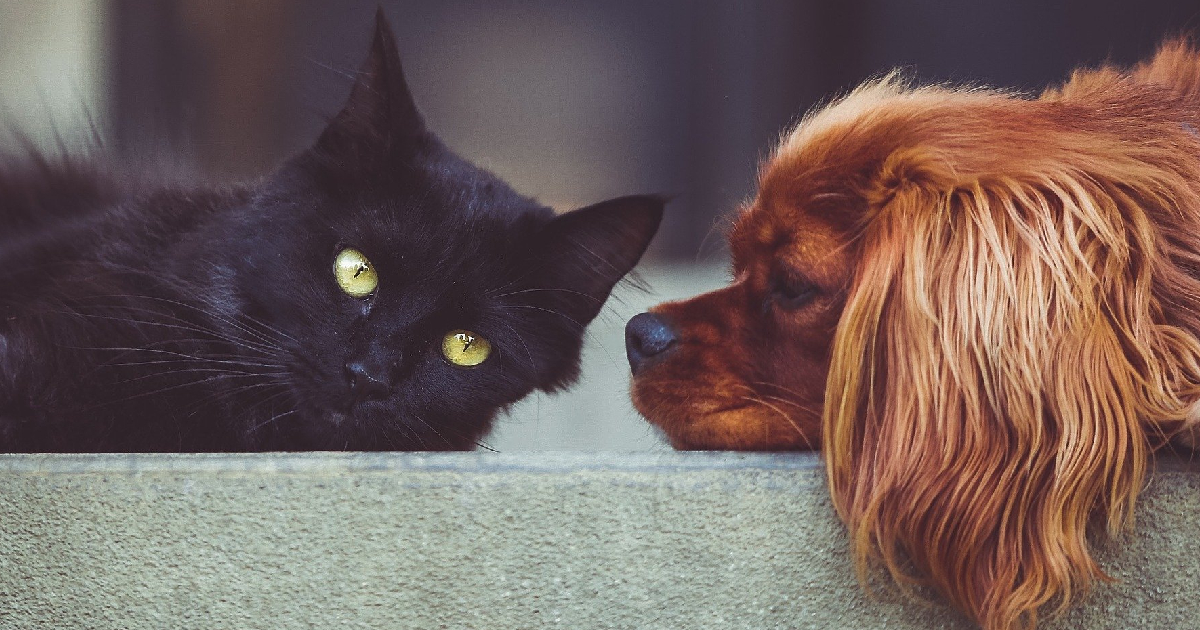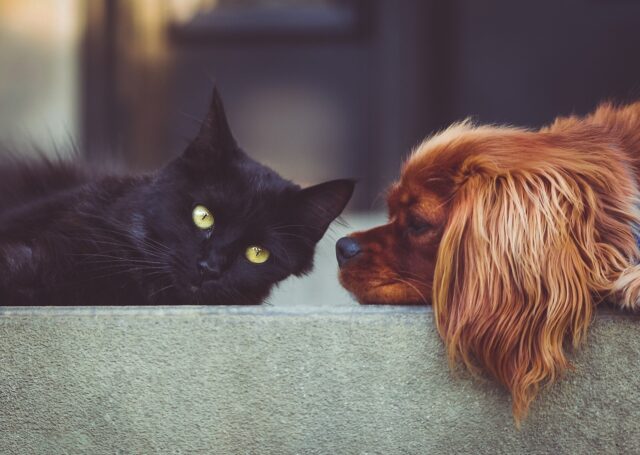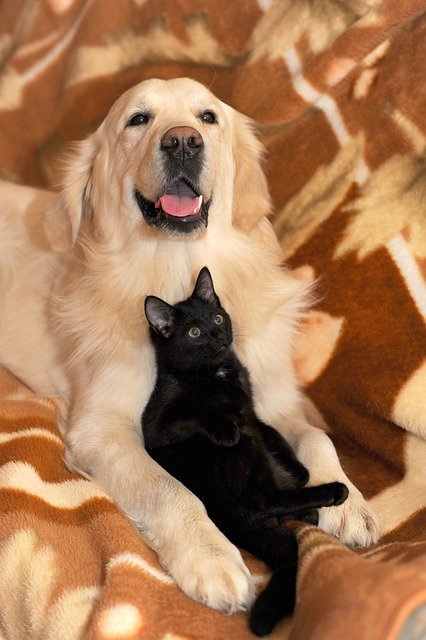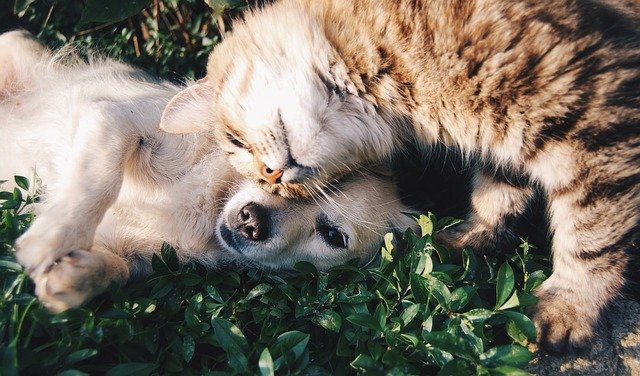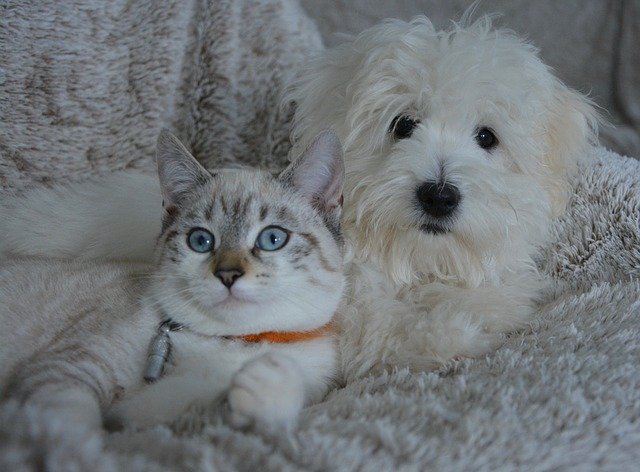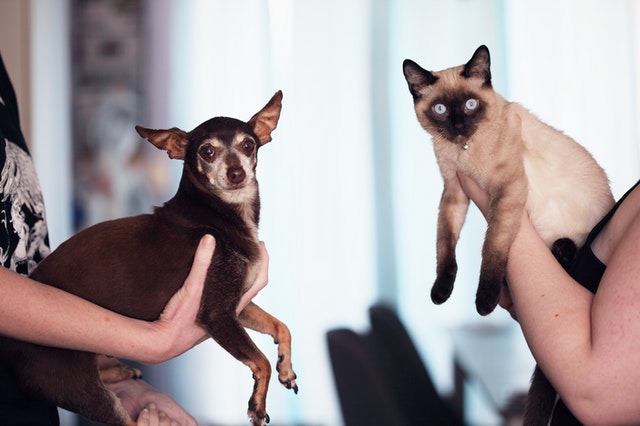Introducing your cat to a dog might sound like a chore, but with a little research and some simple steps, animal parents can encourage their cats and dogs to live in joyous harmony as best buddies. And if not the closest of companions, at least cats and dogs can learn to tolerate each other peacefully!
Dr. Jessica Pierce reveals cats and dogs can exist in close relationships, citing a recent study that concluded canines and felines often adapt to each other better when exposed at young ages. Meaning your cat might enjoy having a dog companion more if she meets the dog in her younger days. This doesn’t mean a senior cat won’t get along with a dog, but kittens are more open to new experiences.
Bringing the dog home to your cat will hopefully make the meeting flow a little better too. Dr. Pierce reports, “The cat being first to arrive in the household also seemed to lead to greater comfort on the part of the cat.”
Follow this helpful information and introducing your cat to a dog won’t seem so daunting.
When Heading to the Shelter to Adopt a Friend for Your Cat
At the shelter or rescue, take your time choosing the right dog for everyone in your family, your cat or cats included. Keep these ideas in mind:
- When adopting a dog to bring into your cat-oriented house, be sure to ask questions. Learn as much as you can about the dog from rescue staff. They may not know much about the dog’s past, but any answers will be good when trying to understand if a particular dog will get along with cats.
- Spend time playing with, talking to, and observing the dog. You can get a good idea if a dog’s personality will mesh well with your cat’s ways from this time together. Also, keep ages in mind, a hyper puppy might not mesh well with a senior cat who enjoys the quiet life. If your cat is a rough-and-tumble tiger, he might enjoy a young playmate to tussle with. Grandpa kitties would probably enjoy a mellow dog who prefers a nap to a romp around the living room.
Be Prepared for Pup’s Arrival
When welcoming a dog into your home, there’s a number of supplies you’ll need on hand to acclimate the dog to their new surroundings. Some of these items will also be handy while introducing your cat to a dog:
- Leash for the dog – Choose a leash with your family’s needs in mind.
- Baby gate – Make sure the gate is tall enough to keep the dog from jumping over it.
- Secure Spaces – Select two rooms with doors that have secure latches neither cat, nor dog can open. Set up each room as a temporary oasis, one for the cat, one for the dog. Stock the rooms with food, water, toys, and beds for each. Place a litter pan in the room for the cat.
- Treats for both cat and dog – Everybody deserves a snack for doing what needs to be done!
Step One: Separate Space for Success
Your new dog has come home and its time to start the slow introductions!
Remember to stay calm and have fun, your energy influences so much when it comes to our animal buddies. But do take things slow and steady to ensure introducing your cat to a dog goes smoothly. The idea is to create a comfy bond between feline and canine.
It may seem like a good thought to introduce your cat to a dog at the shelter, but this actually puts far more stress on the cat. All the unfamiliar smells, sights, and sounds can terrify a cat and leave a stain on the first meeting between cat and dog. As territorial creatures, cats handle everything better on their own turf.
Arriving Home
When your pup first arrives at home, be sure your cat is located in one of those two selected rooms with the door shut. The dog will want to explore, possibly bounding from room to room to learn about his new home. This sudden burst of canine in the house might upset your cat, making it important to lock kitty safely away for the moment.
Once the dog has checked out the new digs, let her settle down in her designated room for a little while. Then, once the dog is secured, let the kitty come out to have a sniff around. Already he knows things are different. He’s been hearing and smelling the dog, giving him an idea of what was taking place in the house prior to his release.
The scents left behind by both cat and dog help the animals to form an idea of who’s in their space. So giving them separate time to sniff each other out will help with upcoming physical introductions.
Taking Turns
For a few days, develop an alternating routine of who’s got run of the house and who is hanging out in their room. This allows your cat time to assert his space has remained the same even if there’s a new occupant in the house. Things smell different, but home still looks like home.
For your new pup, time alone in the house without the cat can help her adjust to new space without worry over feline ambush. The dog will also have time to learn the cat’s scent, and when the time does come for a meeting, the kitty won’t be so overwhelmingly, excitingly new! Which makes for the promise of a calmer first sight.
Once both cat and dog are eating normally, going potty the right ways, and seem at ease in their surroundings, its time to let the fur babes visually meet.
Step Two: Physically Introducing Your Cat to the Dog
Now, its time for your cat and dog to lay eyes on each other. This is where you’re going to need the leash and the treats.
At First Sight
With your cat in one room, leash the dog in another, and slowly enter the room where the cat is hanging out. Be ready for any excitement. If your cat gets spooked, he may try to run and hide. Let that happen if this is what kitty needs.
Plus, keep a tight grip on the dog’s leash in case the cat bolts. Dogs will give chase to a fast-moving object, according to Katherine A. Houpt, James Law Professor of Behavior Medicine, Emeritus at Cornell University’s College of Veterinary Medicine. She explains that even if the fast-moving object is a scared cat, a dog “often feels honor-bound to chase it.”
The leash will not only keep a dog from chasing a cat, but it can also stop the dog from invading the cat’s space even if the kitty isn’t scared. This allows for a calm inspection of each other. If everyone is okay, just hang out with a hold on the leash. Be sure to offer treats to cat and dog alike, along with soft-spoken words of encouragement.
Let Kitty Make the First Move
Curious cats move cautiously, so move slow yourself and encourage your dog to calmness too. Wait and allow your cat to come investigate on her own.
Once everyone is calm, she might come over and investigate the dog up close. Or not. She may wish only to examine the dog from afar. Either way, let your cat have control. This is new and cats are strange about change.
Dr. Cathy Lund of City Kitty, a feline-exclusive veterinary practice, explains, “Cats thrive on predictability and can be control freaks,’ so when their routine or environment is disturbed, they can engage in what veterinarians call ‘defensive aggression.’”
To avoid this fearful aggression, read your cat’s cues, and remove the dog from the room if the cat gets upset. Hopefully, introductions will go smoothly, with the cat either staying and hanging out or trucking on to nap somewhere. Either way, no growling, and no hissing means things are progressing well as you’re introducing your cat to the dog.
And again, treats are your friend! Offering incentives for good behavior helps animals to associate each other with the joy of something good.
Do keep an eye on body language and verbal cues during interactions between cat and dog. If things seem tense or aggressive, separate the animals, reverting back to Step One until calmer meetings occur.
If both cat and dog seem cool and collected, continue these meetings over the next few weeks. Once things feel right and settled, it’s time to move onto Step Three.
Step Three: Unsupervised, But Secretly-Supervised, Time Together
Now, its time for the baby gate and some watching from afar. Select a doorway you can keep an eye on without being noticed by the animals. Place the baby gate there. The idea here is to let the animals spend time together ‘alone’ getting used to each other’s presence. After a time of these gated interactions, you’ll know if the new canine/feline dynamic has settled enough to transition into normal living together.
Once you’ve set the gate, place the cat on one side, and then, release the hound on the other!
Here’s where you’ll see the result of the hard work you’ve put in introducing your cat to a dog.
Ideally, your cat and dog will put nose to nose through the gate, both possessed by the sudden need to be the best of friends. Sure, it’s not usual for cats and dogs to be best friends, but it does happen! Social media offers plenty of proof, but more likely, your cat will deliver a bored sniff and saunter away.
And in the cat world, we can call that success when it comes to introducing your cat to a dog!
Please SHARE to pass on this story to a friend or family member.
